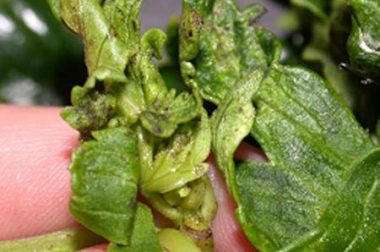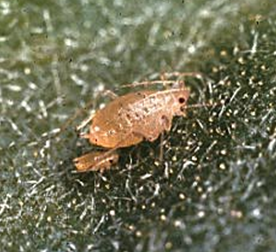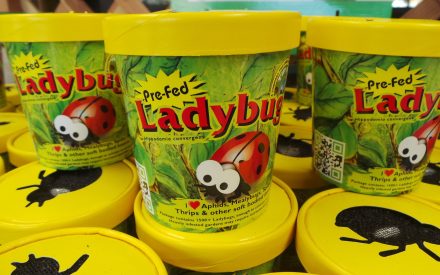
Phil Pellitteri, UW Insect Diagnostic Lab
Revised: 5/7/2010
Item number: XHT1038
Cyclamen and broad mites are extremely small (0.3 mm long) and can be found infesting bedding plants and perennials in the greenhouse and in the garden. Broad mites commonly infest African violet, ageratum, azalea, begonia, dahlia, larkspur, gerbera, gloxinia, ivy, jasmine, impatiens, lantana, marigold, mum, petunia, snapdragon, verbena, and zinnia. Cyclamen mites are found on many of the same plants, as well as on strawberry. The saliva of cyclamen and broad mites is toxic to plants and causes twisting, curling, hardening and distortion of growing points. Infested plants typically appear distorted, have crippled crowns, and have premature bud and flower death. Tissue damage from cyclamen and broad mites may appear similar to damage caused by herbicides or nutrient disorders.
Control: Cyclamen and broad mites are best managed by preventing their introduction into a greenhouse, home or home garden. New plants that might harbor cyclamen or broad mites should be isolated from other susceptible plants for several weeks so that they can be monitored for symptoms typical of a cyclamen or broad mite infestation. If plants are infested, consider discarding them. Buds and crowns that have been crippled and distorted by cyclamen and broad mites, as well as hairy leaves (such as those of African violets), provide protection to the mites and make them difficult to eliminate. However, cyclamen and broad mites are sensitive to heat and can be killed by dipping plants in a 111oF water bath for 15 minutes. Keep in mind that excessive treatment with hot water (e.g., at temperatures higher than 111oF or for more than 15 minutes) may damage plants. In greenhouses or in outdoor gardens miticides containing the active ingredients abamectin, bifenthrin, endosulfan, clorfenapyr, lamda-cyhalothrin or pyridaben can be used for control. Be sure to read and follow all label instructions of the miticide that you select to insure that you use the product in the safest and most effective manner possible.
Download Article





 Insect Pest Management for Greenhouses
Insect Pest Management for Greenhouses Managing Aphids in Greenhouses
Managing Aphids in Greenhouses Managing Thrips in Greenhouses
Managing Thrips in Greenhouses Biological Control of Insects and Mites: An Introduction to Beneficial Natural Enemies and Their Use in Pest Management
Biological Control of Insects and Mites: An Introduction to Beneficial Natural Enemies and Their Use in Pest Management


